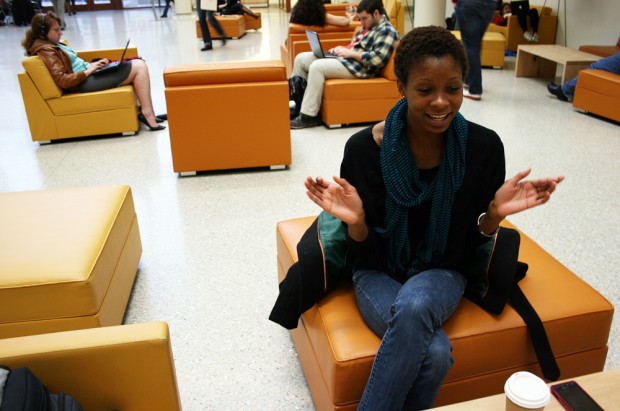Division of Labor: Bright Futures

Image: Carrie Moskal / WAMU
"Division of Labor" is DCentric's examination of D.C.'s unemployment disparity.
This week, DCentric has been exploring unemployment disparities in the nation’s capital. D.C.’s job market attracts professionals from around the country, yet unemployment rates are as high as 26 percent east of the Anacostia River.
The outlook can be grim for young people growing up in these communities, but high joblessness hasn’t stopped some from planning for a future in which they are professionals.
Charnice Cunningham, 21, grew up in Ward 5, where unemployment is 14.7 percent. One of her childhood friends is in junior college, another dropped out of high school and a third is in prison.
“Some people make it. Some people don’t,” she said.
Cunningham is one of those who “made it.” She’s a senior at American University where she studies psychology, with plans to be a teacher or school counselor.

Elahe Izadi / DCentric
Charnice Cunningham, 21, on American University's campus. The psychology senior is from Ward 5, where unemployment is 14.7 percent.
She attributes much of her success to the support of her mother and attending the SEED School, a sixth through 12th-grade public charter boarding school in Ward 7. Students enter as sixth-graders and live on campus during the school week. The school’s mission is to get students to college, and that permeates the environment. Students meet with college counselors and make campus visits. University banners are plastered throughout the cafeteria’s walls. Each dorm room is named after a university. According to SEED, 94 percent of graduates go on to college.
Most SEED students come from Wards 5, 7 and 8, areas with D.C.’s highest unemployment rates. Being from neighborhoods where there is so much joblessness “can jade [students’] perspectives on what opportunities really exist for them,” said Keven Cotton, SEED’s director of external opportunities and internships. To combat this attitude, Cotton said, students should be exposed to new experiences through internships, field trips and study abroad programs.
Anscia Brown, 17, is a senior at SEED and from Ward 7. She said her family has always expected for to go to college.

SEED students each lunch in the school's cafeteria, decorated with college paraphernalia . The school's mission is to prepare students for college.
The majority of D.C.’s available jobs require higher education. Even though it’s easier to get a job with a college degree, the recession has made it difficult for everyone to find work. The unemployment rate for college-educated blacks and Latinos is higher than it is for whites.
“I have a plan, but the way the world is going today, I don’t know if it’s still going to be effective by the time I graduate,” Brown said.
Marcus Murphy, 18, is a SEED senior who wants to become a lawyer. But Murphy, who grew up in Ward 8, has a backup plan: helping run a trash collection business his late-grandfather started. “Do I want to do that, trash? No. But it’s a job, and it’s an option,” he said.
Read More:
Explaining D.C.’s Unemployment Disparities
The Gap Between Skills and Jobs
Immigration and D.C. Unemployment
Sticking around D.C. may offer these students better job opportunities than elsewhere given the District’s job market is one of the best in the country. But many of Cotton’s students don’t see a future for themselves in D.C.
“[Students] tend to focus on graduating and leaving D.C. It’s ironic because you have so many people who flock to D.C. because of the opportunities,” Cotton said.
Violent crime is high in many of these neighborhoods. For students, that can impact “their view of what’s expected of them, or even their chances of survival,” he said. “A lot of students, they feel D.C. for youth can be dangerous. If you can get out, that’s what you do.”
Then there are students who want to leave because they want to experience something different, Cotton added.
“I’ve been here for a very long time, and I think there’s more to the world than Washington, D.C.,” Murphy said.
Brown agreed. “There’s nothing wrong with D.C. I just want to explore the world.”
This post has been updated to reflect newly-released SEED statistics.
-
Brimstone
-
Renee





